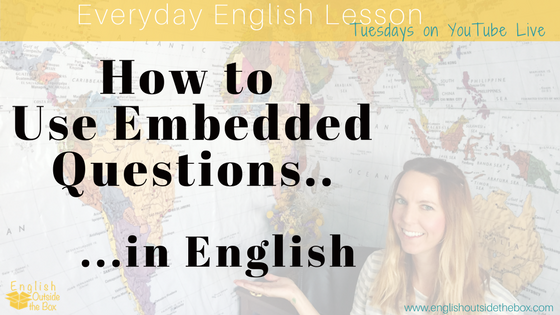
How to Use Embedded Questions in English
I am not sure if you’ve studied embedded questions in English before. Can you tell me in the comments what confusions you have about embedded questions? I am wondering how much you have studied them…
I also hope that you realized this lesson has already begun and includes 3 examples of embedded questions above. Do you notice anything about them that’s similar? Can you identify how they are different than a regular question in English?
If you’re feeling confused or not sure, don’t worry because you’re in the right place!
Last week in my Everyday English lesson on YouTube, I taught the basic structure of questions in English and the topic of embedded questions came up in the live chat. I decided to make the rest of July dedicated to learning more about questions in English.
Embedded questions generally cause some confusion with my English learners, but the mistakes are easy to fix because I see the same one happening again and again (frequently). Today, let’s fix these mistakes and help you better understand how and when to use embedded questions.
In today’s lesson, you’re going to learn:
- the structure of embedded questions
- when to use them
- a common mistake to avoid
Embedded Questions in English
As you know, in order to get information we have 2 types of direct questions: yes/no questions and information questions. A couple of examples of these are, “Do you love English?” or “Where do you live?”, but sometimes we don’t ask questions directly. Instead, we put a question inside of another question or inside a statement. And that is an embedded question.
We do this when we don’t want to be direct or sometimes as a way to start a conversation. In casual conversations, embedded questions are very common.
The biggest mistake with embedded questions is the word order. Usually, learners want to write/say an embedded question in the same way they write/say a direct question. However, this is incorrect.
The embedded question does not follow the standard structure and question order. Most of the time, embedded questions begin with a statement like “I’m not sure”, “I don’t know”, “Let me find out..” or inside of a question: “Can you tell me…”, “Could you tell me…”. The actual information that you want to know [your question] comes at the end.
In all embedded question, the subject comes before the auxiliary or verb and the sentence may or may not have a question mark.
Examples:
Embedded question with a statement: I wonder what I will be doing in 10 years time.
Embedded question with a question: Do you know what I’ll be doing in 10 years time?
*Direct Question: What will I be doing in 10 years time?
Embedded question with a statement: I wonder what you are doing.
Embedded question with a question: Do you know I am doing? Does she know what you are doing?
*Direct Question: Jennifer, what are you doing?
How can you introduce an embedded question?
Some examples of statements to start an embedded question:
- I need to know
- I want to know
- Let’s see
- I wonder
- I am not sure
- Can you tell me…. (?)
- Could you tell me … (?)
- Do you know… (?)
- Can you remember … (?)
Structure of Embedded Questions
- Embedded question inside of a statement
[Introductory Statement + Subject + Auxiliary + Verb]
The statement is followed by the question you want to know. In this case, you are getting the information, but you are not asking directly.
Lets imagine you need to know the time. If you ask directly, the question would be: “what time is it?” (an information question with “what”). An example of an embedded with a statement (I wonder..) would be: “I wonder what time it is.”
*NOTE: If you are asking for information and you want to use an embedded question, include the question word in the embedded question. Also, change the word order to match a statement word order.
Example:
I don’t know where the library is.
I don’t know who she is talking to.
The sentence begins with a statement (I don’t know) and is followed by the question words “where” and “who”.
If your embedded question begins with a statement, don’t include a question mark (?).
- Embedded question inside of a another question
INFO QUESTION: [Introductory Question + Question Word + Subject + Auxiliary/Verb ]
YES/NO QUESTION: [Introductory Question + if/whether + Subject + Auxiliary/Verb ]
- Information Questions
Can you tell me why you study English?
Direct: Why do you study English?
- Yes / No Question
Can you tell me if/whether you love this English lesson?
Direct: Do you love this English lesson?
OTHER IMPORTANT NOTES ABOUT STRUCTURE:
- Modals
I’m not sure if I should purchase a car or an apartment first.
Direct: Should I purchase a car or an apartment first?
—-
I wonder if I should or not have my hair cut.
Direct: Sure I have my hair cut?
*NOTE: If the embedded question begins with a question, include a question mark (?)
- Time tenses
I am not sure when you ate lunch.
Can you tell me when you ate lunch?
I am not sure if you ate lunch
Direct: When did you eat lunch? Did you eat lunch?
Notice that, here, you have to eliminate the auxiliary DID and you must change the verb to the past tense.
Practice Makes Perfect
- Try to write your own embedded questions.
Use the structures we reviewed in this lesson or, even better, try to create your own embedded questions.
- Transform the following direct questions into embedded questions. You can write the answers in your notebook or in the comment below. *Check the answers at the bottom*
- Why did you call your friend?
- Where should we go for lunch?
- Are you happy living there?
- Did they arrive safely?
- What else do you need to know about embedded questions?
ANSWERS ARE BELOW IN A WHITE COLORED FONT. HIGHLIGHT BELOW TO SEE THEM:
-
Can you tell me why you called your friend?
-
I am not sure where we should go for lunch.
-
I don’t know if you are happy living there.
-
Do you know if/whether they arrived safely?
-
I wonder what else you need to know about embedded questions
^Highlight the answers above to reveal.
I hope you enjoyed the lesson and until next time,
Happy Studying! ♥
Embedded questions are important in your everyday conversational English. If you want to learn even more conversational English, then sign up before to receive more information about the Phrasal Verb Conversation Club. The club is a monthly training program with new materials every week!
The Conversation Club will provide you with 6 group conversation calls to practice with a real teacher and a group message community to connect with other members.
You will also get weekly English lessons to help your vocabulary, listening, reading, pronunciation, and more!
Try the Club for 1 week, free! Join the 1-week free trial here.

Plase explain why the order doesn’t change like in:
Do you have any idea whose glasses are these?
Could you please tell me what’s in the “Chicken Surprise Casserole”?
Your first example isn’t correct and the 2nd doesn’t have an auxiliary.
Thank you!
So far I had been so confused with “direct questions” and “embedded questions”, but thanks to you for this lesson, now I don’t have any doubts.
Dear Madam,
What may be the indirect question of : Was he alone? Did you notice…
Did you notice if he was alone? or Did you notice if he had been alone?
I have learnt that there is no tense change in indirect questions. But, some teachers teach that when the sentence starts from past, then there should be the tense change.
I would be grateful if you could reply to me.
Yours faithfully,
Gopal Bhattarai
There could be a variety of ways to create an indirect question with this information. Your example, “Did you notice if he was alone?” works.